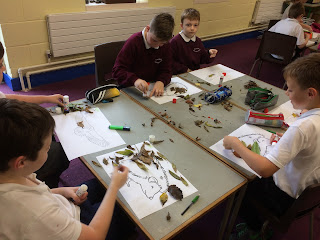Fingerprints
Fingerprinting facts
No two fingerprints are identical.
All of your own fingerprints are different.
Even identical twins, who share the same DNA, have different fingerprints.
Fingerprints can be made by palms of hands, fingertips, soles of feet and surfaces of toes.
Fingerprints are caused by sweat and are detected by the forensic scientist using dyes, chemicals or lasers.
Fingerprinting is the most widely used forensic technique today.
Fingerprints can be used to replace passwords, ID cards and other methods for limiting access to buildings, computers etc.
Romans used branding and amputation to identify criminals.
Later, visual identification using memory and photography was used.
In the late 19th century a Frenchman called Bertillon used a system of measurements of parts of the body to identify people.
In 1900, fingerprints began to be used to identify people.
Fingerprinting facts
No two fingerprints are identical.
All of your own fingerprints are different.
Even identical twins, who share the same DNA, have different fingerprints.
Fingerprints can be made by palms of hands, fingertips, soles of feet and surfaces of toes.
Fingerprints are caused by sweat and are detected by the forensic scientist using dyes, chemicals or lasers.
Fingerprinting is the most widely used forensic technique today.
Fingerprints can be used to replace passwords, ID cards and other methods for limiting access to buildings, computers etc.
Romans used branding and amputation to identify criminals.
Later, visual identification using memory and photography was used.
In the late 19th century a Frenchman called Bertillon used a system of measurements of parts of the body to identify people.
In 1900, fingerprints began to be used to identify people.
Our unique fingerprints
We put scrapped lead from a pencil onto a plate and pressed our finger into it.
We pressed our finger onto the outside of a glass.
We then mixed a small amount of lead from the pencil with talc and brushed it onto the glass to reveal our fingerprint.
5 Interesting Facts about Fingerprints
- The ridges in the shape of loops and spirals that you see on your fingertips and the thumb actually help you to grasp an object. Without them, you will not be able to write or paint properly. Everyone has ridges on the tips of their fingers, so what is special about them? No two fingerprints are exactly alike!
- These ridges on your fingers start forming when you are still inside your mom’s tummy. Our fingers have sweat glands that ooze some oils and salt through tiny pores on the finger surface. This sticky film of sweat and oil trapped in the ridges leaves behind a print when we touch anything. It is difficult to get fingerprints on carpets and clothes as they absorb the oils.
- Scientists compare fingerprints and group them according to the similar ridge patterns they find. The ridges on most people’s fingers resemble a whorl, loop, or an arch. What do yours look like? Just like fingerprints, our retinal print and tongue prints are also unique and cannot be forged by anyone.
- It is for this reason that these unique characteristics of the human body are used for authentication of a person’s identity. The science that involves the study and analysis of human body prints is known as bio-metrics. The bio metric system compares the body prints to the specimen data stored in the system to verify the identity of a person.
- Criminals cannot con this highly advanced technology and will certainly get caught if they try to pass themselves off as someone else. There are highly sophisticated scanners installed in high security facilities that can scan the retinal prints and finger prints and allow a person to enter only after complete verification.
























































